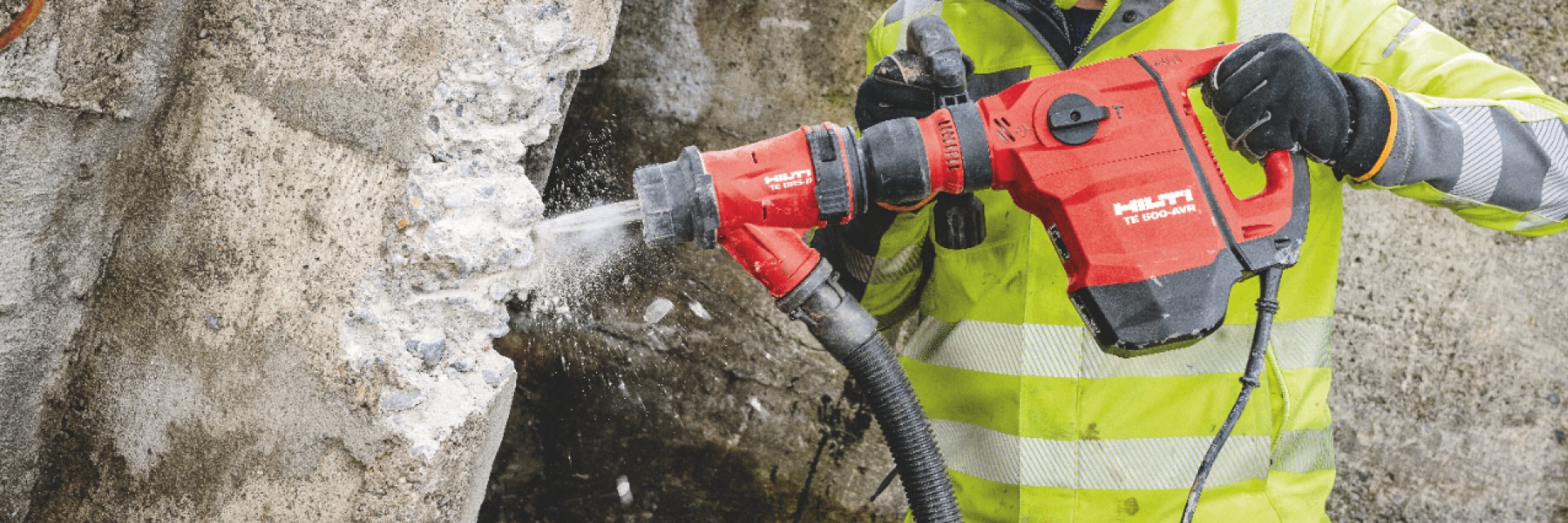- Home
- Homepage
- Dust control
- Crystalline silica is common in construction materials
Crystalline silica is common in construction materials: Here's what to look out for

As one of the most common and severe hazards that workers may come across on a construction site, silica dust is one of the most important areas of occupational health and safety to consider, understand and take action against. An enormous part of this is knowing which materials contain silica dust, and which work practices can be used to minimise exposure.
After all, materials that contain silica are incredibly common on construction sites. Failure to understand the processes that cause these raw materials to produce respirable crystalline silica (RCS) can leave workers exposed to a variety of health risks, including lung cancer and silicosis.
What is respirable crystalline silica?
One common misconception about silica is that it's dangerous in all of its forms. This is not the case, and on its own, crystalline silica is not hazardous to the health of workers on a construction site. When disturbed however, through processes such as drilling or blasting, silica becomes airborne and, when smaller than 10 micrometres in diameter, breathable ('respirable'). At this point, the material has become RCS, and breathing in just a small amount can lead to severe health problems.
The most well-known of these is silicosis, a form of lung inflammation that eventually leads to the formation of scar tissue. The main symptoms of silicosis are shortness of breath, a persistent cough and general weakness, which become more severe after continued exposure. It's important to remember that silicosis is incurable, meaning the best form of defence is prevention.
This is where understanding what raw materials on a site can produce respirable crystalline silica becomes so important.
Where is crystalline silica dust found?
Silica is found in many of the most common raw materials used in construction, including:
- Asphalt
- Brick
- Cement
- Concrete (and concrete block)
- Drywall
- Fibre cement
- Grout
- Shotcrete and gunite
- Mortar and refractory mortar
- Certain paints
- Plaster
- Refractory units
- Rock
- Roofing tiles (clay and ceramic)
- Sand and soil
Various types of stone can also include silica, with examples including limestone, quartz, sandstone, slate and granite. When any of these materials are brought onto the site, they should be accompanied by a safety data sheet (SDS), which will outline not just the presence of silica, but also additional information on everything from toxicological information to the material's geological composition.
In addition to understanding the materials that can produce respirable crystalline silica, it's vital for workers to know what processes put them at potential risk. These include:
- Abrasive blasting
- Cutting
- Coring
- Drilling
- Grinding
- Jackhammering
- Milling
- Mining
- Mixing
- Polishing
- Sanding
- Sawing
- Scraping
- Scarifying
Processes such as sweeping and cleaning up a construction site can be potentially hazardous if any of these processes have taken place beforehand. Accordingly make sure respiratory protection is used in any and every situation involving RCS.
With materials and processes where no silica is believed to be present (such as tunnelling through rock) it's still important to clarify that there is no risk of RCS production, and prepare accordingly. Even one-time exposure can have health repercussions, so make sure to put the safety of your workers first with the right protective equipment and dust control systems whenever processes such as drilling or blasting are being undertaken on a job site.
Identifying and monitoring respirable crystalline silica
Once the presence of RCS has been identified on a construction site, the next step is taking appropriate measures to monitor the levels of exposure that workers are being faced with. From there, it's possible to determine which sorts of protective equipment and dust minimisation processes are best suited to reducing the risk of exposure.
There are two main methods of monitoring silica dust exposure on a construction site. The first is by taking test samples at a worker's location throughout a typical work day, in order to get the best picture of what they're being exposed to. These samples can then be tested to work out how much of the dust is RCS, and from there determine what parts of the job site require the most attention. For example, a worker operating on the other side of a site to where cement is being drilled may not expect to be exposed to RCS, but a sample of the dust around them will provide a definite answer.
While dust sampling is highly effective, it can also be expensive and time-consuming, in addition to being unable to account for the movements of each and every worker on a site. That's why it's so important to supplement any dust sampling with individual health monitoring. This involves regularly testing lung function and respiratory ability, in order to quickly determine whether or not a possible exposure to silica dust is causing the first signs of silicosis.
Of course, there's no use in monitoring silica exposure without having access to the right tools for minimising the hazard. That's where Hilti comes in, with a variety of different dust removal technologies that can keep your site and your employees free from RCS and the damage it causes. To find out more, get in touch today.
